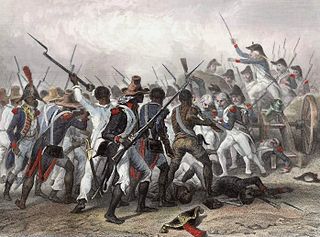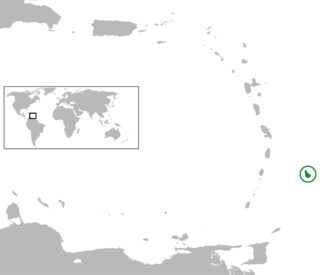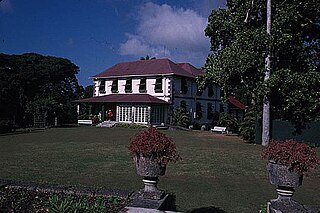
Barbados is an island country and microstate in the Lesser Antilles of the West Indies, in the Caribbean region of the Americas, and the most easterly of the Caribbean Islands. It lies on the boundary of the South American and the Caribbean Plates. Its capital and largest city is Bridgetown.
Barbados is an island country in the southeastern Caribbean Sea, situated about 100 miles (160 km) east of Saint Vincent and the Grenadines. Roughly triangular in shape, the island measures some 21 miles (34 km) from northwest to southeast and about 14 miles (23 km) from east to west at its widest point. The capital and largest town is Bridgetown, which is also the main seaport.

The architecture of the United States demonstrates a broad variety of architectural styles and built forms over the country's history of over two centuries of independence and former Spanish, French, Dutch and British rule.
The music of Barbados includes distinctive national styles of folk and popular music, including elements of Western classical and religious music. The culture of Barbados is a syncretic mix of African and British elements, and the island's music reflects this mix through song types and styles, instrumentation, dances, and aesthetic principles.

The slave codes were laws relating to slavery and enslaved people, specifically regarding the Atlantic slave trade and chattel slavery in the Americas.

The country of Barbados is divided into sub-regions known as parishes.

Bussa's rebellion was the largest slave revolt in Barbadian history. The rebellion takes its name from the African-born slave, Bussa, who led the rebellion. The rebellion, which was eventually defeated by the colonial militia, was the first of three mass slave rebellions in the British West Indies that shook public faith in slavery in the years leading up to the abolition of slavery in the British Empire and emancipation of former slaves. It was followed by the Demerara rebellion of 1823 and by the Baptist War in Jamaica in 1831–1832; these are often referred to as the "late slave rebellions".

Barbadian nationality law is regulated by 1966 Constitution of Barbados, as amended; the Barbados Citizenship Act, as amended; and various British Nationality laws. These laws determine who is, or is eligible to be, a national of Barbados. Barbadian nationality is typically obtained under the rules of jus sanguinis, i.e. by birth to a father or in some cases, a mother, with Barbadian nationality. It can also be granted to persons with an affiliation to the country, or to a permanent resident who has lived in the country for a given period of time through naturalisation. There is currently no program in Barbados for citizenship by investment, though they do have a special work visa program. Nationality establishes one's international identity as a member of a sovereign nation. Though it is not synonymous with citizenship, rights granted under domestic law for domestic purposes, the United Kingdom, and thus the Commonwealth, has traditionally used the words interchangeably.
The Barbados Land-ship is a cultural movement and organization, known for its entertaining parades, performances and dances. Members are said to mimic the British Navy, dressed in naval uniforms and marching and performing to the music of the Tuk band. However, it is a lot more than entertainment. The organization was started in the island of Barbados after Emancipation, by the earliest plantation workers of African Descent to help them develop socially and economically. The Barbados Land-ship Association is the umbrella body and is essentially a Friendly Society. Each community had a Land-ship. It is based on a cooperative system, operating within communities and providing common services to them. The Land-ship, as it is locally known, has been an oral tradition handed down from members to members from the time of its establishment in 1863. It is held among the ranks of Barbados' cultural symbols such as the "Mudda Sally" and the "Shaggy Bear", but in much more esteem as a "cultural icon unique to Barbados". It is thought that the Land-ship existed long before it became officially established and that the ways of the Land-ship were practiced within the plantation communities of African slaves long before Emancipation Day. This would account for the interpretation of Land-ship maneuvers as re-enactments of the Middle Passage, an experience that would have been embedded into the minds of the first shipments of enslaved Africans to Barbados. During the latter part of slavery, slaves were bred and the plantations had very little need for imported slaves.

The culture of Barbados is a blend of West African and British cultures present in Barbados. English is the official language of the nation, reflecting centuries of British influence, but the Bajan dialect in which it is spoken is an iconic part of the Barbadian culture. This dialect is a combination of the languages from the different inhabitants in its history. Barbadian culture is influenced by the Indigenous Caribs, Africans, Europeans and South Asians.

A prefabricated building, informally a prefab, is a building that is manufactured and constructed using prefabrication. It consists of factory-made components or units that are transported and assembled on-site to form the complete building.

The following is an alphabetical list of topics related to the nation of Barbados.

Francia Great House is a historical plantation great house in Saint George, Barbados. It is on a wooded hillside near Gun Hill Signal Station.
A Jewish population has been in Barbados almost continually since 1654.

Chattel house is a Barbadian term for a small moveable wooden house that working class people would occupy. The term goes back to the plantation days when the home owners would buy houses designed to move from one property to another. The word "chattel" means movable property so the name was appropriate. Chattel houses are set on blocks or a groundsill rather than being anchored into the ground. In addition, they are built entirely out of wood and assembled without nails. This allowed them to be disassembled and moved from place to place. This system was necessary historically because home "owners" typically did not own the land that their house was set on. Instead, their employer often owned the land. In case of a landlord tenant dispute, the house could be quickly moved to a new property.
Indo-Barbadian or Indo-Bajan, refers to Barbadians of Indian ancestry from the Indian subcontinent, including present-day Bangladesh and Pakistan. Currently, there is a 3,000-strong Indian community in Barbados.

The Chamberlain Bridge is a bridge in Bridgetown, the capital and largest city of the nation of Barbados. In 1872, it was a swing bridge across the marine inlet channel of the inner basin of the Careenage at Carlisle Bay. The outmoded steel structure was dismantled and rebuilt in 2005–2006 as a lifting bridge with the state-of the-art modern technology of an all-composite single-leaf bascule design. This design is a counterweighted bridge span that pivots upward, permitting pleasure craft to pass through an inlet channel. The bridge was built using fibre-reinforced plastic (FRP), which is lighter, long lasting and non-corrosive.

The Parliament Buildings, is the seat of the Parliament of Barbados. Built between 1870 and 1874, the buildings have been the meeting place for both chambers of Parliament since 16 June 1874, and a former site of Colonial administration of Barbados. It consists of two buildings in the neo-Gothic architectural style, and are reminiscent of the Victorian era of Great Britain.

Black Barbadians or Afro-Barbadians are Barbadians of entirely or predominantly African descent.














